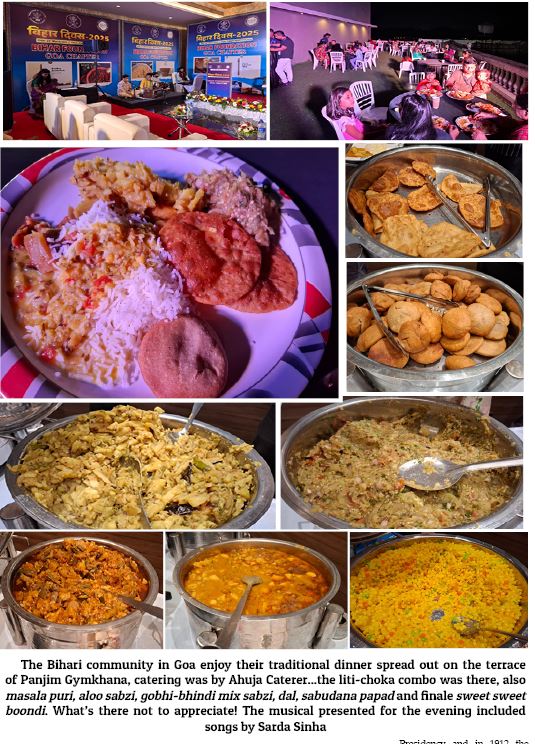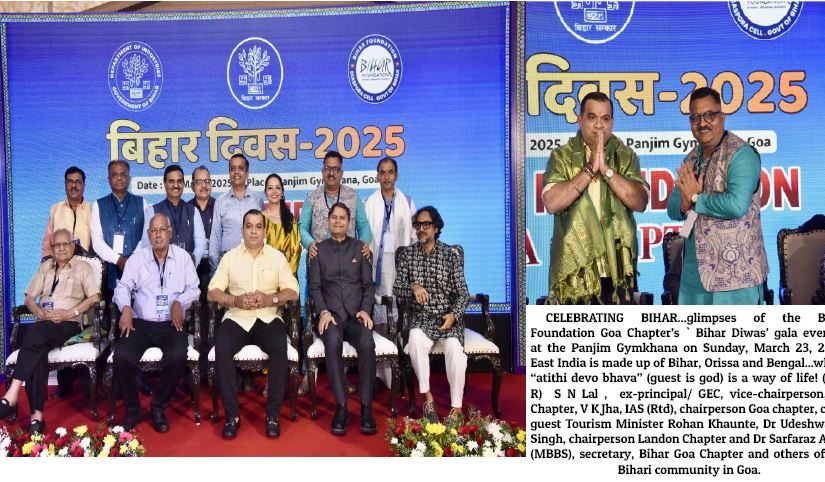By Tara Narayan
GOA is becoming quite a mini-India cocktail now like it or not! The flavor of the state currently is…Bihar. Everybody including the government has been celebrating Bihar Diwas or Bihar Day. Do you know there is a Bihar Foundation Goa chapter (a body of Ministry of Industry ,government of Bihar) which is concentrating on changing the popular image most of us have of Bihar being one of our “bemaru” states, its people perennially impoverished despite its magnificent history and past (Ashoka the Great lived here, Buddhism took root here and much else), despite Chief Minister Nitesh Kumar’s very many credentials for being a great chief minister.
Bihar has driven its people to migrate to West Bengal for ages to eke out a living; and migration is still on except that perhaps it’s the wealthy Bihari business folk who leaving for more sophisticated or cosmopolitan places like Goa. Who doesn’t love Goa!
SORRY, in my junketing around India I haven’t made it to Bihar but some things Bihari I do love including some of its famous cuisine item numbers. India is amazing because of its diversity of cuisine, so distinctive to each state.…although there are common fusions now, I’m against any modern-day bhelpuri degeneration of some recipes identified with each state, hope it never happens.
ANYWAYS, there I was at the Bihar Diwas celebration at the Panjim Gymkhana on Sunday, March 23 biting later on into this most divine crusty “liti” (the first half of the combo dish “liti-choka” of Bihari cuisine fame) and almost forgetting the “choka”… I thought there was also an exhibition of things Bihari on and so had gone for a dekho.
No exhibition but Goa’s Bihari community was here in a splendid gathering with musicals, talks, later followed by a gala dinner featuring several of Bihar’s piece de resistance goodies like “liti-choka” along with masala puri competing with the “liti” dumplings. A Saurabh Misra in response to a query said maybe the community is 10,000 families strong in Goa, but I must confirm with Bihar Foundation Chapter’s Uma Shankar if I can find him.
There was singing by Sarda Sinha and Pandit Pravin Chowdhury from Vasco da Gama offered a fulsome talk about being Bihari or “Biharwasi.” A tradition-bound people mostly, please don’t think of them as “paraya” (aliens) in Goa! Bihari people believe in one India or “sampurna Bharat” and hospitality or “atithi devo bhava” (guest is god) is ingrained in them…they have their own food, are passionate about observing “chaat puja” on the beaches, much more.
Later Tourism Minister Rohan Khaunte came in as chief guest and waxed lyrical about Bihar being part of ancient civilization and land where Gautam Buddha was born, was famous for the Nalanda University and library…that in general we are 28 states of different tradition and culture and “at the end of the day we are all Indians. We must love each other’s culture for that’s how incredible India is, every state has its own story and soon we will be a most powerful economy…if we work together in nano ways.” As tourism minister he has in the last two years promoted Goa beyond its sun, sea and sand; tourists should explore the hinterland of Goa which has so much to offer, because of the many temples he was all for promoting Goa as “dakshin Kashi.”
He added, from Bihar or Goa we are here to be together and we can contribute so much and work towards an “akhand Bharat” which is Prime Minister Narendra Modi’s aspiration. Tired of sitting too much I got up and went out of the hall to see if the good was laid out and I could photograph it and go home…of course I ended up eating some of the familiar Bihari delicacies! Yes, there was “liti-choka,” excellent masala puri, a couple of veggies, babycorn fritters, several chaat presentations and I rather liked the sweet boondi by way of sweets for a change, everyone else preferred the ice-cream I think. It was a very good Bihar Diwas dinner and done by Ahuja Caterers.

MADE friends with the gracious Sushila Umesh Karan seated next to me who told me she lives in Panjim, she said I may call her up if I needed more enlightenment on the subject of Bihar food like “googni” and “kachri” and the way they cook fish, “we eat a lot of sattu.” Basically, sattu is protein-rich gram flour featuring in several dishes, in fact “litti” is just a dough ball stuffed with a spiced up “sattu filling” and deep fried or baked in live ambers…they also have “sattu paratha, khaje, dal pitha” and “chokha” which combines with “litti” is nothing but a “bhartha” of mashed brinjal, potatoes, tomatoes, tangy deliciousness. If you ever go to Bihar, she said, eat their much loved kararni rice chawal or rice, a unique tasting aromatic rice variety growing in Bhagalpur and Banka districts, it’s much in demand…they also have karuppu kavuni rice or black rice, for some reason “forbidden rice”because it’s a traditional nutrient rich heirloom rice originating from Tamilnadum. The rice takes on a deep black purple color upon cooking and is considered to have many health benefits.
Then Bihar is famous for its Shahi litchi from the Muzaffarpur ditrict, “lychee kingdom.” The sweets have a roll call like “thekua, khaja, parwal ki mithai, tilkut, makhana kheer, anarsa and laai.” More interesting than of our modern day mithai shop fare!
BIHAR has an interesting, formidable history. Read up and go visit one of these days, a pity it continues to be one of India’s poorest states and despite Chief Minister Nitish Kumar being considered a dynamic chief minister. However, in its glorious past it was known as Magadha in ancient times, a centre of power, learning and culture. Remember, it is here the Maurya empire rose and gave birth to one of our most pacifist religions, Buddhism. The Maurya and Gupta empires unified large parts of South Asia under a central rule.
Pataliputra, modern Patna, was the capital of Magadha, an important centre of Indian civilization. Many important non-religious books like the Arthashashtra and Kamasutra were composed here 2000 years back. Vaisali, one of the first known republics, existed here since before the birth of Mahavira (c.599 bc).
Later the Muslim invasions just about destroyed all the glory by end-12th century. Mohammad Bin Bakhtiar Khilji destroyed many of the viharas (Buddhist sanghas) and the famed universities of Nalanda and Vikramshila. Thousands of Buddhist monks were massacred and faded away during the medieval period…then came the British East Indian company. Bihar was part of the British-ruled Bengal Presidency and in 1912 the provinces of Bihar and Orissa were formed, in 1936 they were split from the rest of British-ruled India and became independent states. Bihar got statehood on January 26, 1950. Do read up Bihar before travelling there. Be a traveler and not a tourist!
